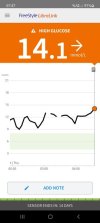crunnycrun
New Member
- Relationship to Diabetes
- Type 1
Hi. I'm type 1 and have been for 20 years after being diagnosed at the age of 23.
I recently got the sensor and have Been using for maybe three months now. I can't seem to figure out why when I check in the morning, my glucose levels have been yo-yoing all night. Not going into hypo but going down then up etc.
Anyone know why this could be?
Thanks.
(I'm aware that my levels are high in the pic)
I recently got the sensor and have Been using for maybe three months now. I can't seem to figure out why when I check in the morning, my glucose levels have been yo-yoing all night. Not going into hypo but going down then up etc.
Anyone know why this could be?
Thanks.
(I'm aware that my levels are high in the pic)


